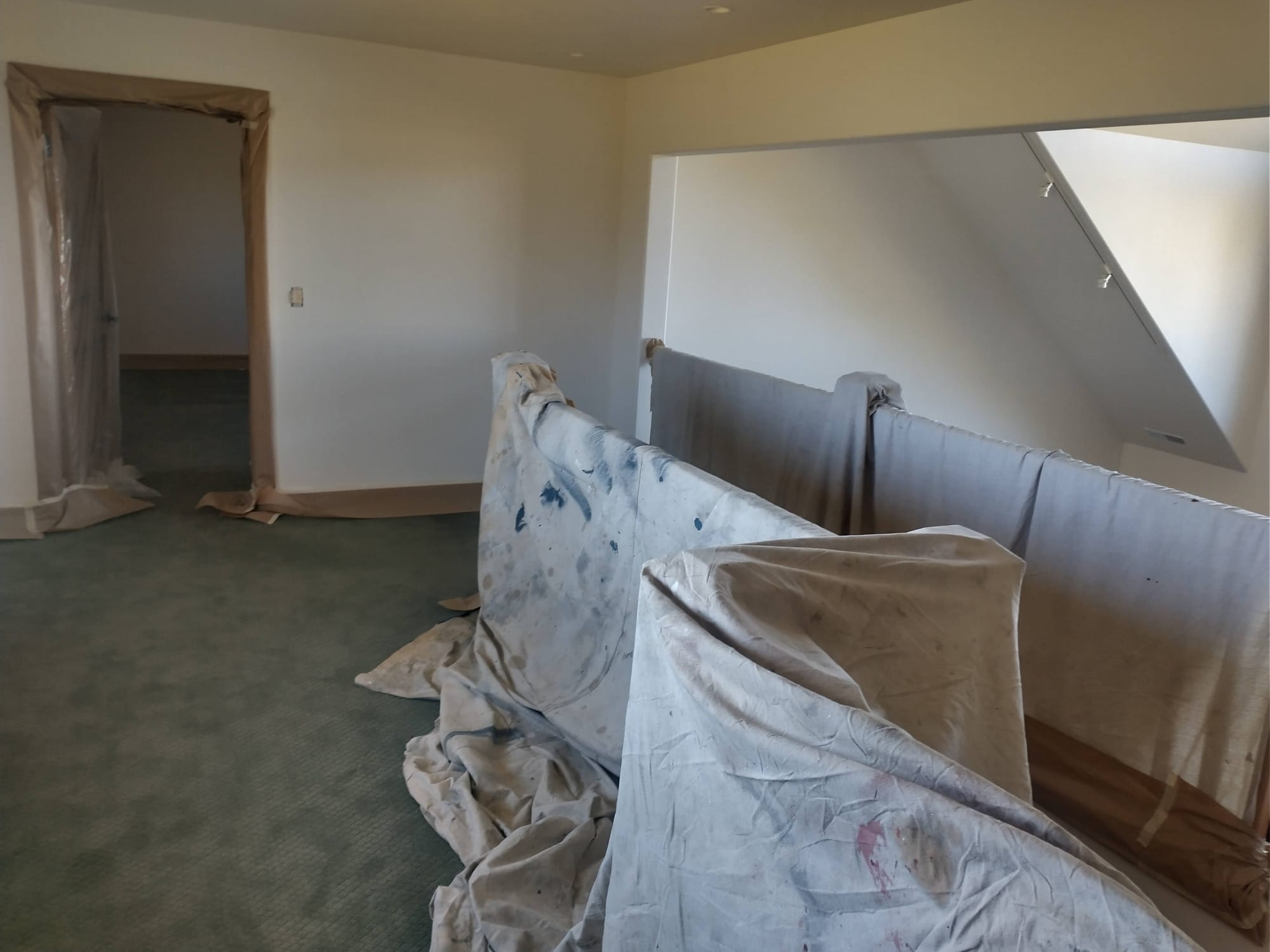Laying the Groundwork: Wall and Ceiling Prep

Key Highlights:
- Understanding the differences between acrylic and latex paint can significantly impact the outcome of your project.
- Acrylic paint offers superior durability and flexibility, making it ideal for outdoor and high-moisture areas.
- Latex paint is easier to apply, dries faster, and is generally more cost-effective for interior projects.
- Consider the environmental impact, especially VOC levels, when choosing between the two types of paint.
Wall and Ceiling Prep for a Perfect Paint Job
When it comes to achieving a professional-quality paint finish, preparation is everything. Skipping prep might seem tempting, but taking the time to properly prepare your walls and ceiling can make a huge difference in the final outcome and longevity of your paint job. Here’s everything you need to know to get your walls and ceilings ready for paint like a pro, especially if you’re working on older surfaces or dealing with common issues like cracks, stains, or uneven textures.
Why Is Wall and Ceiling Prep So Important?
Prepping walls and ceilings before painting ensures that your paint adheres properly, looks even, and stays flawless over time. In high-moisture environments like Portland, Oregon, or if your home is subject to frequent temperature changes, proper wall and ceiling prep becomes even more crucial to avoid issues like bubbling, peeling, or cracking.Here’s a rundown of the benefits:
- Better Adhesion: A smooth, clean surface helps paint stick better.
- Longer-Lasting Results: Prepped walls prevent premature peeling or chipping.
- Professional Finish: Proper prep ensures a smoother and more even look.
Step 1: Inspect Your Surfaces
Before you dive into scrubbing and patching, take a close look at your walls and ceiling to identify any issues.
- Look for Cracks and Holes: These are common in older homes and need to be filled.
- Check for Stains or Mold: Water stains or mildew can bleed through paint if not handled correctly.
- Uneven Texture: Consider smoothing out rough areas, especially on ceilings, for a cleaner look.
How Do You Clean Walls and Ceilings Before Painting?
Cleaning is a crucial first step that many people overlook, but paint doesn’t adhere well to dusty or greasy surfaces. Here’s how to clean different types of surfaces effectively:
Walls
- Dust the Surface: Use a microfiber cloth or a vacuum with a brush attachment to remove dust.
- Wash with Soap Solution: For general grime, mix a few drops of mild dish soap with warm water. Use a sponge to wash the walls, rinsing with clean water afterward.
- Degrease High-Traffic Areas: Kitchens, bathrooms, and children’s rooms may have grease or residue buildup. Use a degreaser, especially near the cooking area or places where fingerprints are common.
Ceilings
- Dust First: Use an extendable duster or vacuum to remove cobwebs and dust.
- Remove Stains with Vinegar Solution: For light stains, mix equal parts white vinegar and water, lightly dab the ceiling, then rinse with a damp cloth.
- Tackle Mold: For ceilings with mold or mildew, especially in Portland’s damp climate, use a solution of one part bleach to three parts water.
Things to Know
- Project Suitability: Choose acrylic paint for outdoor durability and latex for indoor ease.
- Health Considerations: Opt for low-VOC latex paints indoors to safeguard health.
- Cost Implications: Consider acrylic for fewer repaints despite higher initial costs.
- Environmental Concerns: Latex offers lower VOC emissions, aligning with eco-friendly practices.
- Professional Insight: Consulting with experts like Lightmen Painting can optimize your paint selection and application method for any project.
How to Repair Cracks, Holes, and Imperfections
With clean surfaces, it’s time to address any structural issues on your walls and ceiling. Here’s a step-by-step for common repairs:
- Filling Holes and Cracks: Use a spackling compound or joint compound to fill small holes or cracks. For larger imperfections, use a patch kit.
- Sand Smooth: After the filler dries, sand it down until the patched area is flush with the wall or ceiling.
- Prime the Patch: Apply a thin coat of primer to any patched spots to ensure even paint absorption and color.
Should You Use Primer on Walls and Ceilings?
The short answer is yes, primer is essential for achieving a flawless, long-lasting finish, especially on new drywall, repaired areas, or when drastically changing colors. Here’s a guide to choosing and using the right primer:
- New Drywall: A high-quality drywall primer seals the surface, making it ready to take paint.
- Stain-Blocking Primer: If your walls have water stains, nicotine, or smoke stains, use a primer specifically designed to block these.
- Mildew-Resistant Primer: For bathrooms or basements in Portland, consider a mildew-resistant primer to keep mold at bay.
How Many Coats of Primer Are Necessary?
Typically, one coat is sufficient, but if you’re covering a particularly dark color or a surface prone to stains, consider applying two coats for best results.
The Importance of Sanding for Smooth Walls
Sanding creates a surface that’s easy for paint to grip onto, helping prevent streaks and uneven patches. For walls and ceilings, sanding can be done as follows:
- Choose the Right Grit: Use 120- to 150-grit sandpaper for light sanding and 80-grit for more intensive smoothing.
- Use a Sanding Block or Pole: A sanding block or pole gives even pressure and avoids over-sanding. For ceilings, a pole is especially helpful to avoid constant ladder moves.
- Wipe Away Dust: After sanding, wipe down walls and ceilings with a damp cloth or tack cloth to remove all dust.
Masking and Protecting Your Space
To achieve a clean, professional finish, you’ll want to tape off areas where you don’t want paint to go, such as moldings, trim, and light fixtures. Here’s how to protect your room effectively:
- Use Painter’s Tape: Apply tape along the edges of trim, ceiling lines, and other areas to create sharp, clean lines.
- Protect Floors and Furniture: Lay down a canvas drop cloth over floors and move or cover any furniture to keep it paint-free.
- Remove Outlet Covers and Switch Plates: This gives you a more seamless finish and helps avoid paint splatters on your hardware.
In Our Experience:
"We've found that choosing the right type of paint not only enhances the project's aesthetics but significantly affects maintenance and durability. Whether opting for the robustness of acrylic in a bustling cafe or the quick-dry convenience of latex in a residential bedroom, our tailored approach ensures long-lasting satisfaction and superb finish."
Final Checks Before Painting
You’re almost ready to paint! Just a few final checks can ensure your hard prep work pays off.
- Dry Time: Make sure everything is completely dry before applying paint, especially if you used water or primer.
- Touch Up Any Missed Spots: Inspect for any cracks, dents, or holes you may have missed and patch as needed.
- Dust and Clean Again: Give the surfaces a quick final wipe-down to catch any lingering dust particles.
Top-Quality Paints and Primers for Portland’s Climate
Portland’s humidity can affect paint durability, especially on ceilings. Choosing the right products can make a difference in long-term performance. Here are a few recommended products for walls and ceilings in high-humidity areas:
- Sherwin-Williams Duration Home: This paint has excellent washability, perfect for high-traffic walls.
- Behr Premium Plus Ultra: Known for its mildew resistance and stain-blocking properties, it’s a solid choice for ceilings in bathrooms or kitchens.
- Kilz 2 All-Purpose Primer: Great for covering stains and preparing surfaces in humid environments.
Final Thoughts
Preparing walls and ceilings for painting may take time, but it’s well worth it for achieving a professional, durable finish. With the right cleaning, repairs, priming, and attention to detail, you’re setting up for a paint job that will stay vibrant and flawless for years.Proper prep is what transforms a good paint job into a great one, and when done well, it saves you from frequent touch-ups and ensures a beautiful look in your Portland home.
Do You Have Questions? Give Us A Call With Any & All! 503-389-5758
-
People Also Ask:
What are the main differences between acrylic and latex paint?
Acrylic paint is known for its durability and flexibility, making it suitable for outdoor environments and areas exposed to harsh conditions. It's made with a synthetic resin that helps it withstand the elements. Latex paint, on the other hand, is water-based and popular for indoor walls and ceilings due to its quick-drying nature and ease of cleanup.
Why should I choose low-VOC paints for indoor projects?
Low-VOC (Volatile Organic Compounds) paints are recommended for indoor projects because they emit fewer harmful chemicals into the air, improving indoor air quality and reducing health risks. These paints are particularly important in enclosed spaces or homes with children, the elderly, or those with respiratory issues.
Can acrylic paint be used indoors as well as outdoors?
Yes, acrylic paint can be used both indoors and outdoors. Its versatility is due to its durable nature, which makes it resistant to weathering and capable of retaining color and finish over time. However, due to its strong odor and chemical composition, proper ventilation is essential when using it indoors.
-
SUBSCRIBE TO OUR BLOG: Stay informed with the latest in Painting and DIY projects by subscribing to Lightmen Painting. Get insights, tips, and more delivered straight to your inbox. We would also love to know what you would like to read about, leave thoughts on where we should go next. Interests, Topics, Ideas, all are welcome.
Answer: Wall & Ceiling Prep
If your in the Portland, Or. area and need advice or a free no obligation estimate call us at 503-389-5758 or email scheduling@lightmenpainting.com
Shout Out:
Celebrating D & L Quality Construction: Dedicated to Quality Real Estate Development
D & L Quality Construction is synonymous with exceptional real estate development in Portland. Their commitment to quality aligns perfectly with our own high standards at Lightmen Painting. Trust D & L for your next construction project.
Thanks for stopping by Lightmen Daily! Stay tuned for more practical tips and expert advice on making your painting projects flawless, from wall to floor!
Definitions
- Acrylic Paint: A type of paint made with a synthetic resin as the binder, known for its durability and ability to resist weathering.
- Latex Paint: Water-based paint, which uses synthetic polymers as binders. Known for its quick drying time and ease of use.
- VOCs (Volatile Organic Compounds): Organic chemicals that have high vapor pressures at room temperature and can affect indoor air quality.
- Sustainability: Measures how environmentally friendly a paint is, considering factors like VOC levels and the impact on indoor and outdoor environments.
- Durability: The ability of paint to withstand wear, pressure, or damage; crucial for paints used in high-traffic or exposed areas.
- Flexibility: Refers to a paint’s ability to expand and contract without cracking, essential for outdoor applications.
- Ease of Application: How simple the paint is to apply, including factors like drying time and required equipment.
- Longevity: The length of time paint will last before it needs a touch-up or repainting.
- Cost-Effectiveness: Evaluates the initial cost versus the long-term benefits of a paint, including maintenance and frequency of repainting.
- Environmental Impact: Considers the effects of paint products on the environment, focusing on factors like VOC emissions and sustainability.
Lightmen Painting Serving: Portland, Tigard, Lake Oswego, Tualatin, West Linn, Milwaukie, Sherwood, Happy Valley, Oregon City, Beaverton, Hillsboro, Gresham -Trade Partners-

